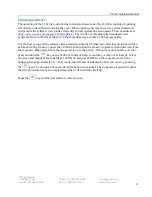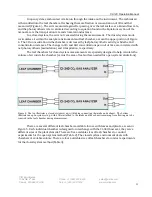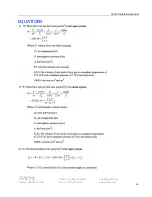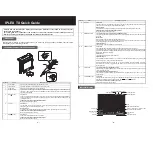
CI-340 Operation Manual
CID Bio-Science
1554 NE 3
rd
Ave
Camas, WA 98607, USA
Phone: +1 (360) 833-8835
Fax: +1 (360) 833-1914
sales@cid-inc.com
www.cid-inc.com
29
Figure 2: Photosynthesis occurs in chloroplasts in leaves, converting carbon dioxide and water to glucose using energy
from sunlight.
Photosynthetic Active Radiation (PAR)
Photosynthetically or photosynthetic active radiation (PAR) is the range of wavelengths of solar
radiation that photosynthetic organisms are able to use for photosynthesis. Only about 44% of the total
electromagnetic energy reaching the earth has the correct wavelengths for use by plants and of that
only 0.5% - 3% is used for photosynthesis. Solar radiation from 400 to 700 nanometers is within the
spectral range (wavelength) for photosynthetic organisms. This range is often referred to as
photosynthetically active radiation or PAR. This spectral range is very similar to the range of light
visible by the human eye (390-750 nm). The CI-340 measures PAR with silicon diode sensors mounted
near the leaf chamber. The sensor measurement is cosine corrected.
Using PAR as a measure of radiant power is important in evaluating the effect of light on plant
growth. The photosynthetic response correlates better with the number of photons than with energy.
This is expected because photosynthesis is a photochemical conversion where each molecule is
activated by the absorption of one photon in the primary photochemical process. PAR is defined in
terms of photon (quantum) flux, specifically, the number of moles of photons in the radiant energy
between 400 nm and 700 nm. One mole of photons is 6.0222 x 10
23
photons (Avagadro’s Number).
Transpiration
Transpiration is the evaporation of water from plants, mainly occurring on the leaves when the
stomata are open and thus allowing the passage of CO
2
and O
2
during photosynthesis and respiration.
Transpiration also can occur in the stem, flowers and roots of plants. Leaf transpiration occurring
through stomata can be thought of as a necessary metabolic "cost" as the stomata open to allow the
diffusion of CO
2
for photosynthesis. Transpiration also enables the mass flow of mineral nutrients and
water from the roots to the shoots of the plant, as well as regulating the
plant’s temperature.
Transpiration is the primary determinant of leaf energy balance and plant water status. The
rate of transpiration is determined by the accumulation of water vapor flux per one-sided leaf area in a
given time and therefore is directly related to the degree of stomatal opening, and to the evaporative
demand of the atmosphere surrounding the leaf (see equation section in this manual). There are
Summary of Contents for CI-340
Page 3: ......
















































